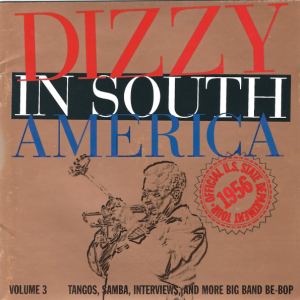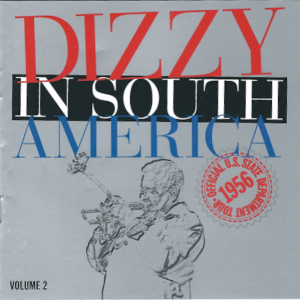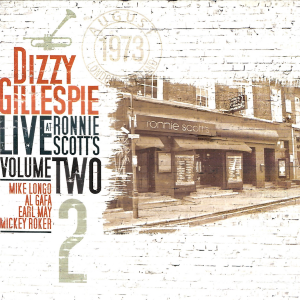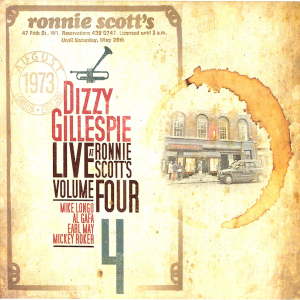Dizzy Gillespie in South America Vol 1
$9.97
Cool Breeze, Groovin’ for Nat, I CanÕt Get Started, Jessica’s Day, A Night in Tunisia, Seems Like You Just DonÕt Care,Flamingo, Stella By Starlight, School Days, Manteca
The first of 3 Volumes of Previously Never Released Dizzy Gillespie. Already In the line up of nominations for The Grammy’s “The best historical recording” for 1999.
In 1956, Dizzy was asked by the State Department to assemble a big band to tour South America.
These recordings were done live throughout the tour with great success. These recordings represent a pinnacle in Dizzy Gillespies’ remarkable career as Band Leader and Trumpet Icon.
– Ira Gitler
Dizzy Gillespie:
Leader and Trumpet
Quincy Jones, Bama Warwick, and E.V. Perry: Trumpet
Phil Woods and Jimmy Powell: Alto Sax
Benny Golson, Billy Mitchell: Tenor Sax
Marty Flax: Baritone Sax
Melba Liston, Frank Rehak, and Rod Levitt: Trombone
Austin Cromer: Vocals
Walter Davis Jr.:Piano
Nelson Boyd: Bass
Charlie Persip: Drums
About “Dizzy Gillespie In South America Vol 1”
Now we can all hear what the band was doing in South America, beginning on Volume 1 with Tadd Dameron’s “Cool Breeze,” taken at a faster pace than in the old days. This is one of the arrangements that Billy Eckstine let Gil Fuller have for the second Gillespie band, five days before it was to open at the Spotlite in 1946. Trombonist Frank Rehak, who stylistically was coming behind Earl Swope, opens the soloing with a combination of fluidity and rich tone. Gillespie is up next. Here a quote from Bama Warwick is in order. In Dizzy’s book, to BE or not to BOP, Warwick says, “Diz was really at his peak. He was really fired up playing in front of that big band…”
Bama was referring to the Middle East tour, but he could just as well have been talking about Latin America. Dizzy’s chops are phenomenal, with imagination to match. Sprinkled into his leaping solo are quotes from “Hawaiian War Chant” (altissimo), “The Hut-Sut Song,” and Illinois Jacquet’s “Bottoms Up.” You can hear the crowd in a stirred-up state before the saxes begin to riff behind Diz. Then Billy Mitchell’s tenor sax keeps the temperature at its elevated state. Dizzy comes back for a second helping, melding with the band to a close.
Ernie Wilkins’ “Groovin’ for Nat” (Hentoff, as you might rightly assume) is an airy, sophisticated swinger with Charlie Persip kicking away. Gillespie’s two solo spots sandwich Mitchell’s, and there’s a short bit from a distant Walter Davis.
In a studio version of “Can’t Get Started,” Quincy Jones gets credit for the arrangement. Perhaps he did the orchestration, but the introduction/ending, which Dizzy created for his small-band version in 1945 and also utilized on “Round Midnight,” is present here, as are the figures under his opening interpretation of the melody, also from 1945.
Quincy’s insinuatingly syncopated theme, “Jessica’s Day” (another dedication to a member of the Hentoff family, this time Nat’s daughter Jessica), grooves along, giving the first bridge to Mitchell. Then it’s Dizzy and Phil Woods’ mobile alto sax splitting a chorus, followed by some well-grooved ensemble work with a little time out for Davis at another one of those sad pianos.
In Gillespie’s big-band format for his “A Night in Tunisia,” the trombone always transmits the exotic theme. Rehak helps establish the mood before the table is set for the dazzling Diz catapulting seamlessly into his solo with one of his classic suspended beginnings. Tenorist Benny Golson, with his Byas-ed stylings, catches the air of mystery well, and bassist Nelson Boyd (the man for whom “Half Nelson” was named) plucks a sonorous solo. Dizzy’s coda caps the trip with a climactic exclamation point. Then, in a variety of languages, he thanks the audience for its applause before stating some multilingual toasts.
Then it’s Austin Cromer’s turn in the spotlight. Judging by his efforts here, it is hard to figure out why he never made it. His voice is effective in all registers. He can shout, as on “Seems Like You Just Don’t Care,” where Gillespie solos; and croon, amply demonstrated by “Flamingo,” where lead alto saxist Jimmy Powell is heard in solo. Cromer’s dramatic ballad style is Eckstine-tinged (in a way he reminds me more of Al Hibbler) but he has his own sound within the genre.
“Stella by Starlight” is the first of two Melba Liston arrangements. Gillespie interprets the melody, interweaving and alternating with the chart in which Liston uses the song’s arresting harmonic structure to her advantage. Diz solos more broadly toward the end, topping it off with his heavenly chops.
The band shuffles off to “School Days,” with Davis plinking away before expanding his single line, which includes a reference to ‘The Peanut Vendor.” Vocalist Gillespie updates the old nursery rhyme, having a lot of fun, and Mitchell comes on like a bar-walker with some rock-house tenor that, even in its semi-parody, cooks like crazy.
Volume 1 of this tour closes with “Manteca,” one of Dizzy’s hits. It’s all here: the ‘I’ll never go back to Georgia,’ chant; the maestro’s flights over the Latin vamp; the theme; a short solo from Mitchell; and an even shorter one from Dizzy. The rhythm section takes over at this point with bass bone and cowbell in the mix. Soon the ensemble is into the ‘Is-tan-bul, Con-stan-ti-nople’ groove, and you know Diz is dancing. Persip, an inspiring helmsman throughout, brings it back into the ‘Manteca’ vamp and out with the main theme never restated.
There you have Volume I of Dizzy in South America. Volumes 2 and 3 will be issued in the near future. They will not only contain more exciting big-band sides but also some very special recordings Dizzy made with a samba band in Brazil and a tango ensemble in Argentina!”
– Ira Gitler






